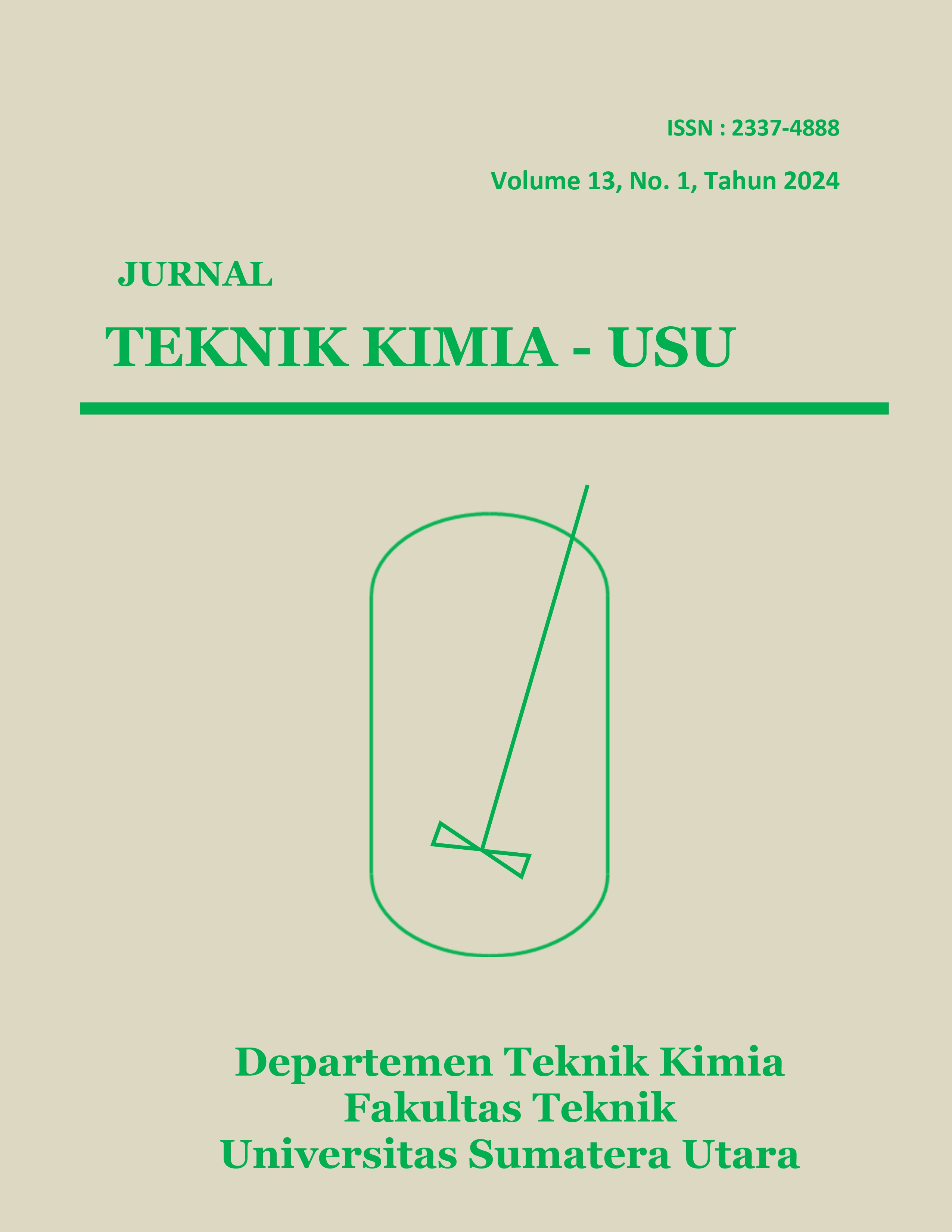Analisis Pengaruh Penambahan Magnesium Oksida terhadap Sifat Mekanis Bioadhesif Berbasis Kitosan-Karagenan
DOI:
https://doi.org/10.32734/jtk.v13i1.14656Keywords:
benzoyl peroxide, bioadhesive, chitosan, filler, magnesium oxideAbstract
This study investigates the effect of magnesium oxide (MgO) as a filler in enhancing the bioadhesive properties of chitosan and carrageenan-based adhesives. The primary focus is on improving tensile strength, viscosity, solid content, and thermal properties. The results indicate that the addition of 0.75% w/v MgO significantly increased tensile strength from 9.76 kPa to 21.76 kPa and viscosity from 34.26 cP to 617 cP with a 0.5% w/v MgO addition. The solid content also increased from 9.81% to 13.19% with increased MgO concentration. The addition of benzoyl peroxide (BPO) reduced curing time, enhancing process efficiency. Scanning Electron Microscopy and Fourier Transform Infrared Spectroscopy confirmed improvements in structural and chemical stability, while Differential Scanning Calorimetry showed better curing efficiency. This study suggests MgO as a potential filler to improve mechanical properties and adhesion of bioadhesives, relevant for medical applications.
Downloads
References
H. Zhu, J. Tian, H. Mao, and Z. Gu, “Bioadhesives: Current hotspots and emerging challenges,†Curr. Opin. Biomed. Eng., vol. 18, p. 100271, 2021.
D. E. Packham, “Adhesive technology and sustainability,†Int. J. Adhes. Adhes., vol. 29, no. 3, pp. 248–252, 2009.
R. Pinnaratip, M. S. A. Bhuiyan, K. Meyers, R. M. Rajachar, and B. P. Lee, “Multifunctional biomedical adhesives,†Adv. Healthc. Mater., vol. 8, no. 11, pp. 1–17, 2019.
B. Cohen, M. Panker, E. Zuckerman, M. Foox, and M. Zilberman, “Effect of calcium phosphate-based fillers on the structure and bonding strength of novel gelatin-alginate bioadhesives,†J. Biomater. Appl., vol. 28, no. 9, pp. 1366–1375, 2014.
Y. L. Uscátegui, S. J. Arévalo-Alquichire, J. A. Gómez-Tejedor, A. Vallés-Lluch, L. E. DÃaz, and M. F. Valero, “Polyurethane-based bioadhesive synthesized from polyols derived from castor oil (Ricinus communis) and low concentration of chitosan,†J. Mater. Res., vol. 32, no. 19, pp. 3699–3711, 2017.
X. Lu et al., “Magnesium oxide-crosslinked low-swelling citrate-based mussel-inspired tissue adhesives,†Biomaterials, vol. 232, no. September 2019, p. 119719, 2020.
N. I. Torres et al., “Safety, formulation and in vitro antiviral activity of the antimicrobial peptide subtilosin against herpes simplex virus type 1,†Probiotics Antimicrob. Proteins, vol. 5, no. 1, pp. 26–35, 2013.
Y. Park et al., “Contact tracing during coronavirus disease outbreak, south korea, 2020,†Emerg. Infect. Dis., vol. 26, no. 10, pp. 2465–2468, 2020.
O. Pinkas, O. Haneman, O. Chemke, and M. Zilberman, “Fiber-reinforced composite hydrogels for bioadhesive and sealant applications,†Polym. Adv. Technol., vol. 28, no. 9, pp. 1162–1169, 2017.
A. S. Ulihin, Y. G. Mateyshina, and N. F. Uvarov, “All-solid-state asymmetric supercapacitors with solid composite electrolytes,†Solid State Ionics, vol. 251, pp. 62–65, 2013.
S. Koesman, D. Bennet, and B. Pancasakti, “Analisis kuat geser perekat alami berbahan soy protein isolate dengan variasi natrium sulfit dan asam oksalat,†Jurnal Teknik Kimia USU, vol. 12, no. 2, pp. 62–69, 2023.
B. F. Han, G. Q. He, X. C. Wang, and Z. J. Guo, “Late carboniferous collision between the tarim and kazakhstan-yili terranes in the western segment of the south tian shan orogen, central asia, and implications for the northern xinjiang, western china,†Earth-Science Rev., vol. 109, no. 3–4, pp. 74–93, 2011.
S. Magalhães et al., “Brief overview on bio-based adhesives and sealants,†Polymers (Basel)., vol. 11, no. 10, 2019.
A. I. Esterhuizen et al., “Precision medicine for developmental and epileptic encephalopathies in Africa—strategies for a resource-limited setting,†Genet. Med., vol. 25, no. 2, 2023.
N. Zang et al., “Resveratrol-mediated gamma interferon reduction prevents airway inflammation and airway hyperresponsiveness in respiratory syncytial virus-infected immunocompromised mice,†J. Virol., vol. 85, no. 24, pp. 13061–13068, 2011.
Downloads
Published
Issue
Section
License
Copyright (c) 2024 Jurnal Teknik Kimia USU

This work is licensed under a Creative Commons Attribution-ShareAlike 4.0 International License.

















